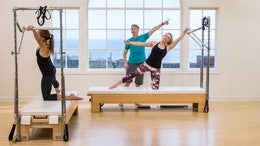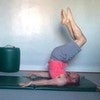Description
About This Video
Transcript
Read Full Transcript
Hello everybody. I'm Jonathan Oldham. Here at Pilates Anytime to share my take on the stability, mobility model of the joints of the body. Each joint of the body has different characteristics or specific qualities. And we define some joints to have a quality of more mobility and some joints have a quality of more stability.
For example, the ankle tends to be more mobile while the knee tends to be more stable. And the hip is mobile and the pelvis and spine are more stable. And surprising to me, is the thoracic spine is to be more mobile. And I feel that for me and most people I meet, that is not the case. There is an epidemic of thoracic stiffness and restriction probably due to our lifestyle.
And so today I'm going to give you a kind of what I call hygiene mat program that we can do to help with developing more mobility in the hips and in the thorax and developing more stability in the pelvis and spine. This program can be used to prepare yourself for your mat work, to inform your mat work or any of your Pilates work or maybe to do a pole class. We're gonna start with percussive breath. And the percussive breath is a mobility exercise. It develops that lateral motion, it's really almost a three-dimensional motion of the rib cage.
Someone the other day said oh it's a full panorama. So we're gonna get the full panorama of motion in the rib cage as you inhale and exhale. The arms are just going to go to the side and back to reflect what's happening in the rib cage. Here we go. Inhale through the nose.
(inhales deeply) Exhale through the mouth. (exhales deeply) (inhales deeply) (exhales deeply) (inhales deeply) (exhales deeply) (inhales deeply) (exhales deeply) Keep breathing and as you're breathing I'm going to tell you that another thing that I've been focusing on in my work is what's called listening. Listening is something I learned when I took a visceral manipulation class but I think we can do it to ourselves. It's just a way of checking in to all the different segments of the body and feeling where things tend to be restricted and feeling where things tend to kind of collapse. So what I'm gonna ask you to do is just take your hands right on top of the head.
I like to just bring this part of the hand here, this metacarpal, the top of the metacarpal right on the top of the head. And very lightly you press down. Very very lightly. Kind of like how you would place your hand on someone's shoulder if you were going to be reassuring. So it's not a strong compression.
It's just a light compression. And you're gonna breath, keep breathing. I hear you all still breathing out there. And you're going to sense where the body tends to kind of want to side bend. Usually you can feel kind of a collapse into a side bend and that's probably a part of the body that needs a little bit more attention or care.
So as you press down and breath, just feel the body and feel where there might be a need for a little more attention, what segments need a little more attention. Change your hand so the other one's on top. Just for symmetry and balance. Let's take four more breaths. (inhales deeply) (exhales deeply) (inhales deeply) (exhales deeply) (inhales deeply) (exhales deeply) (inhales deeply) (exhales deeply) So just take note of where that was for you.
Now I'm gonna ask you to just take your right foot back. Back as far as you can without any shift in the pelvis. We're just gonna do a little lunge. The center axis, you just go straight down your center axis. The arms go to the side.
And lift. And forward. And lift. Inhale, exhale. Inhale, exhale.
Here we go. (inhales deeply) (exhales deeply) (inhales deeply) (exhales deeply) (inhales deeply) (exhales deeply) (inhales deeply) (exhales deeply) Switch legs. And. (inhales deeply) (exhales deeply) (inhales deeply) (exhales deeply) (inhales deeply) (exhales deeply) (inhales deeply) (exhales deeply) (inhales deeply) (exhales deeply) (inhales deeply) (exhales deeply) (inhales deeply) (exhales deeply) (inhales deeply) (exhales deeply) Bring the feet together. Take one foot back.
And we're just gonna lunge all the way down. Down, down, and down. And back. So this here is one of my favorite Fletcher pieces because it engages and awakens the deep intervertebral muscles of the spine. So the emphasis here is in the core muscle, core muscles of the spine.
Those interwoven deep braided muscles of the spine. So you're going to feel those muscles engage and illuminate. And inhale, you lift your feet without losing your alignment. Exhale, curve back. Emphasize the curving of the lower spine.
Inhale, you rise back up. Use your bicep muscles just to give yourself a little bit more lift and then you lower the feet down. So it goes. (inhales deeply) (exhales deeply) (inhales deeply) Assist with the biceps and down. It's inhale, exhale.
And inhale. Exhale. I'm gonna breathe it, here we go. (inhales deeply) (exhales deeply) (inhales deeply) (exhales deeply) (inhales deeply) (exhales deeply) (inhales deeply) (exhales deeply) (inhales deeply) (exhales deeply) (inhales deeply) (exhales deeply) (inhales deeply) (exhales deeply) (inhales deeply) (exhales deeply) Very good. What you're going to do now, I'm just gonna face you so you can see, is you're going to twist the hips.
So one hip internally rotates, one hip externally rotates. Back to center. And just take stock again of where you feel restriction, where things move readily. Just notice where the hips want to go or if there's any obstruction or challenge on the way. And we go.
Inhale. Exhale. (inhales deeply) (exhales deeply) (inhales deeply) (exhales deeply) (inhales deeply) (exhales deeply) Next we're gonna lie on the back. And what I'm gonna ask you to do is keep your left leg straight, bend your right knee, place the foot flat. We're gonna put the fingertips on the top of the pelvic bones so that you can feel if you are level through the pelvis.
And first we're just gonna do a simple bend knee fall out. So this is where the knee goes to the side, the hip externally rotates while the pelvis stays stable. And back to center. Inhale, to the side. Exhale, center.
(inhales deeply) (exhales deeply) (inhales deeply) (exhales deeply) Now you go to the side. (inhales deeply) And extend the leg. (exhales deeply) (inhales deeply) (exhales deeply) Striving to keep the pelvis level and stable. (inhales deeply) (exhales deeply) (inhales deeply) (exhales deeply) (inhales deeply) (exhales deeply) (inhales deeply) (exhales deeply) (inhales deeply) (exhales deeply) (inhales deeply) (exhales deeply) (inhales deeply) (exhales deeply) (inhales deeply) (exhales deeply) Other side, extend the right knee, bend the left, place the foot flat. Four just to the side.
Inhale and exhale. (inhales deeply) (exhales deeply) (inhales deeply) (exhales deeply) (inhales deeply) Adding the extension. (inhales deeply) (exhales deeply) (inhales deeply) (exhales deeply) (inhales deeply) (exhales deeply) (inhales deeply) (exhales deeply) (inhales deeply) (exhales deeply) (inhales deeply) (exhales deeply) (inhales deeply) (exhales deeply) (inhales deeply) (exhales deeply) (inhales deeply) (exhales deeply) (inhales deeply) (exhales deeply) (inhales deeply) (exhales deeply) (inhales deeply) (exhales deeply) Now you're gonna just extend the left leg lying. And this time the arms go out to the side. And you're going to rotate onto that left side.
So you rotate onto your left side. And then you extend the leg long from there, bend and come back. (inhales deeply) (exhales deeply) (inhales deeply) (exhales deeply) (inhales deeply) (exhales deeply) (inhales deeply) (exhales deeply) Over and extend. Bend. Pull the belly in.
Over and extend. Bend. The core brings you back. Two more. And extend.
(inhales deeply) (exhales deeply) (inhales deeply) (exhales deeply) (inhales deeply) (exhales deeply) Other side. And. (inhales deeply) (exhales deeply) (inhales deeply) (exhales deeply) (inhales deeply) (exhales deeply) (inhales deeply) (exhales deeply) As you go over, the opposite shoulder strives to stay down. I'm striving. And over.
Two more. (exhales deeply) (inhales deeply) (exhales deeply) Feeling the control from the center of the body. And down. Bending the right knee again, the left leg extends. What we're gonna do now is the opposite kind of motion.
So the right leg is gonna stay where it is. The foot presses down. You're going to rotate your pelvis about a stable leg. And back to center. Exhale to rotate.
Inhale back to center. (exhales deeply) (inhales deeply) (exhales deeply) (inhales deeply) (exhales deeply) The knee just holds it's place. The right knee just holds it's place. (exhales deeply) And other side. Bend the left knee.
Place the foot flat. And we rotate the pelvis about a stable femur. (exhales deeply) (inhales deeply) (exhales deeply) (inhales deeply) (exhales deeply) (inhales deeply) (exhales deeply) Two more. (exhales deeply) (inhales deeply) (exhales deeply) And that should get your hips mobile but also strong. From here I'm gonna ask you just make a diamond.
You're gonna rise up to sitting tall. Take your fingers now on the shoulders and what I'm gonna ask you to do is just exhale as you twist your thoracic spine. You just twist, twist, center. You keep your sit bones anchored on the mat. And this position, the ribs always wanna flare so you have to keep the ribs contained.
Hopefully they're contained. And we go. (exhales deeply) (inhales deeply) (exhales deeply) I'm keeping the focus forward so that I really am emphasizing that thoracic motion. (exhales deeply) It's a lateralization of the ribs. Meaning that your ribs just kind of move laterally away from your sternum.
(exhales deeply) (inhales deeply) (exhales deeply) (inhales deeply) (exhales deeply) (inhales deeply) (exhales deeply) (inhales deeply) One more. (exhales deeply) Back to center. Starting to get the thoracic spine to rotate, to move separately, to develop pliancy in that part of the body. We tend to think of the ribs as this solid cage but there's a lot of mobility available within the rib cage if we would just use it. From here I'm gonna ask you to lie face down and we're going to just do some kind of a swan pattern.
It's a little bit like the work we do on the long box. So what I'm gonna ask you to do is reach your arms up, crack a walnut between the shoulder blades, and then we're just going to lift up. This is your inhale. Squeezing the blades together. Exhale.
Come forward into the arrow position where the head and neck follow the line of the spine. Inhale, lift. (inhales deeply) Exhale to lower. (exhales deeply) Inhale lift. (inhales deeply) Exhale to lower.
(exhales deeply) Inhale, lift. (inhales deeply) Exhale, lower. (exhales deeply) Inhale, lift. (inhales deeply) Exhale and lower. Sitting back now on the heels.
Here's another thoracic rotation. So we're back on the heels and so the lower spine and pelvis are pretty fixed in place, fixed in space. And you're going to twist to your left. You pull the elbow up and extend and look up. And back to center and to the other side.
Inhale and exhale. Inhale and exhale. (inhales deeply) (exhales deeply) (inhales deeply) (exhales deeply) (inhales deeply) (exhales deeply) (inhales deeply) (exhales deeply) (inhales deeply) (exhales deeply) (inhales deeply) (exhales deeply) (inhales deeply) (exhales deeply) (inhales deeply) Two more. (inhales deeply) (exhales deeply) (inhales deeply) (exhales deeply) (inhales deeply) (exhales deeply) (inhales deeply) (exhales deeply) Come forward onto your abdomen again. And we're just gonna lift the hands now behind the head.
You're in your slight swan. Here's another rotation. So you're gonna take your right elbow to the mat. Inhale. Exhale.
Inhale. Exhale. (inhales deeply) (exhales deeply) (inhales deeply) (exhales deeply) Twist. And center. Twist.
And center. Twist. And center. Twist. And center.
And sit back once again on the heels. From here we're gonna come to four point kneeling. And again to the best of your ability, you try to keep the pelvis and spine stable, the lower spine stable, to the best of your ability. I'm gonna try very hard. But it's a striving, it may not be perfect.
You don't wanna drive yourself crazy. You just try to do it well. So we're going to extend the right leg long. I like to just keep the leg on the floor as long as possible just to stay oriented. Then you lift up to an extension.
Engaging the muscle of the bum crease, you're really engage the glute to lift the leg. Flex the foot. Come forward. Point and reach. Flex the legs and look at the foot.
Point and reach. And I try to reach my right pelvic bone, my right A-S-I-S, to the mat as I come around. Just in opposition to the motion. And reach and flex. And reach.
And switch, here we go. We extend the leg. Lift up. Striving for symmetry. And we go.
Flex. And point. (inhales deeply) (exhales deeply) (inhales deeply) (exhales deeply) (inhales deeply) (exhales deeply) (inhales deeply) (exhales deeply) (inhales deeply) (exhales deeply) (inhales deeply) (exhales deeply) (inhales deeply) (exhales deeply) And come down. So here's a great opportunity to do a plank. So let's go ahead and do that.
We're gonna just come up into this plank position. If you prefer to be on your elbows go ahead and do that. I'm just gonna slide forward and back. Like I'm doing a long stretch on the reformer. And with a sense of striving to protract the scapula to some degree.
Forward and back. And then little circles. Striving to maintain a protraction in the shoulder blades as I circle around and circle around. And bend. And come up.
From here let's go ahead and lie back down again on the back. And we're going to do a bridge. And what is going to happen here, is we're not going to segmentally move. I'm just gonna ask you to just lift up, kind of as a block. Since we're focusing on pelvic and spinal stability, I'm gonna ask you to just lift up in a unit.
Then you reach your arms over head. From here you're going to lift the heels four times. Lift and lower. Lift and lower. Lift and lower.
Lift and lower. Lower the spine down, keep reaching through the arms. And the arms come down. Full breath to lift the spine. (inhales deeply) (exhales deeply) Full breath to reach overhead.
(inhales deeply) (exhales deeply) Breathe for your heel lifts. (inhales deeply) (exhales deeply) (inhales deeply) (exhales deeply) (inhales deeply) (exhales deeply) (inhales deeply) (exhales deeply) (inhales deeply) Lower the spine. (exhales deeply) Lower the arms. (inhales deeply) (exhales deeply) One more time. (inhales deeply) (exhales deeply) (inhales deeply) (exhales deeply) (inhales deeply) (exhales deeply) (inhales deeply) (exhales deeply) (inhales deeply) (exhales deeply) (inhales deeply) (exhales deeply) (inhales deeply) (exhales deeply) (inhales deeply) (exhales deeply) Once again you're gonna make a diamond.
Take your hands inside your knees. Pull yourself up to sitting. And we're in this diamond position. We're gonna do one of Ron Fletcher patterns, one of my favorites, called the hip hurtch. I think it's a good one to do given our theme today of mobilizing the thorax and mobilizing the hips 'cause it does both.
First we'll just mark it through and then we'll do it. So what you're gonna do first is, I'm gonna go to my left but you go to your right so it's mirroring you. So you're gonna go to your right hip. And the whole side of the leg is anchored and planted on the floor. So you get that position.
Your focus stays front. But your arm reaches to the side. So your focus is front your arms reach to the side. And you don't wanna hide yourself like this. You're down.
And we do eight pulses. The pulse is that thoracic motion, that lateralization. And it's also a reach of the arm and shoulder blade. We do eight of them. Then the arm comes up, the arm comes up.
And you bring this sit bone deliberately done back in line, not twisted like that, but down. Let's do the other side. So you'll go to your left, I'll go to my right. You cross the arm over. Your focus is forward.
The foot is flat. Eight pulses. One arm. Balance. And place.
I'm going to do it and breathe and you follow along. Here we go. (inhales deeply) (exhales deeply) (inhales deeply) (inhales deeply) (exhales deeply) (inhales deeply) (inhales deeply) (exhales deeply) (inhales deeply) (inhales deeply) (exhales deeply) (inhales deeply) (exhales deeply) (inhales deeply) (inhales deeply) (exhales deeply) (inhales deeply) (inhales deeply) (exhales deeply) (inhales deeply) (inhales deeply) (exhales deeply) (inhales deeply) (exhales deeply) (inhales deeply) (inhales deeply) (exhales deeply) (inhales deeply) (inhales deeply) (exhales deeply) (inhales deeply) (inhales deeply) (exhales deeply) (inhales deeply) (exhales deeply) (inhales deeply) (inhales deeply) (exhales deeply) (inhales deeply) (inhales deeply) (exhales deeply) (inhales deeply) (inhales deeply) (exhales deeply) How'd we do? Since we're here, let's go ahead and go right into your seal. Bring your hands underneath and find your balance.
Now if you don't roll that's fine. 'Cause really the reason I added this is because of the hip piece. So you could just sit here and clap. We'll do our three claps and roll back. Three claps and come up.
Clap, clap, clap. Clap, clap, clap. Clap, clap, clap. Clap, clap, clap. And what I always say is, the reason we do this exercise is so that we don't take ourselves too seriously.
And. I should breathe, here we go. Inhale. Exhale. (exhales deeply) (inhales deeply) (exhales deeply) (inhales deeply) (exhales deeply) Now you're gonna lie on your side.
And what I like to do with this one, I don't like this position 'cause it just seems kind of twisted. So sometimes I'll even put something underneath this leg. For now I'm just gonna be on what they call the walk so that I'm level in my pelvis. Bottom leg is straight and lifted up. Turn out.
So the knee points down and we do a little pulse. (inhales deeply) (inhales deeply) (exhales deeply) (inhales deeply) (inhales deeply) (exhales deeply) (inhales deeply) (inhales deeply) (exhales deeply) (inhales deeply) (inhales deeply) (exhales deeply) (inhales deeply) (exhales deeply) (inhales deeply) (exhales deeply) And for the sake of symmetry and balance, we'll do the other side. Lay yourself out. Pelvis is stacked as best you can. Lift.
Turn the knee towards the mat. And we pulse. (inhales deeply) (inhales deeply) (exhales deeply) (inhales deeply) (inhales deeply) (exhales deeply) (inhales deeply) (inhales deeply) (exhales deeply) (inhales deeply) (inhales deeply) (exhales deeply) (inhales deeply) (exhales deeply) From here lie on the back. We're gonna take the hands behind the head. And bring the knees in and up.
We're gonna do a hello goodbye pattern. So you pull the belly in. And as you reach the right leg down you pull the right belly in extra. Back to center. Left.
Back to center. So it's as if the right leg says goodbye. And hello. And the left. Goodbye.
And hello. We breathe. (inhales deeply) (exhales deeply) (inhales deeply) (exhales deeply) (inhales deeply) (exhales deeply) (inhales deeply) (exhales deeply) (inhales deeply) (exhales deeply) (inhales deeply) (exhales deeply) (inhales deeply) (exhales deeply) (inhales deeply) (exhales deeply) So let's rise up to standing. Here we are. Come around.
Up to standing. Once again we're gonna do our listening. Take the hand just at the crown of the head. Gently give yourself a little reassuring pressure. Notice if anything's changed.
(inhales deeply) (exhales deeply) Switch hands. (inhales deeply) (exhales deeply) (inhales deeply) (exhales deeply) Bring your arms down. And now you're ready to face your day, in the words of Joe Pilates, with spontaneous zest and pleasure. Thank you.
Comments
You need to be a subscriber to post a comment.
Please Log In or Create an Account to start your free trial.



























